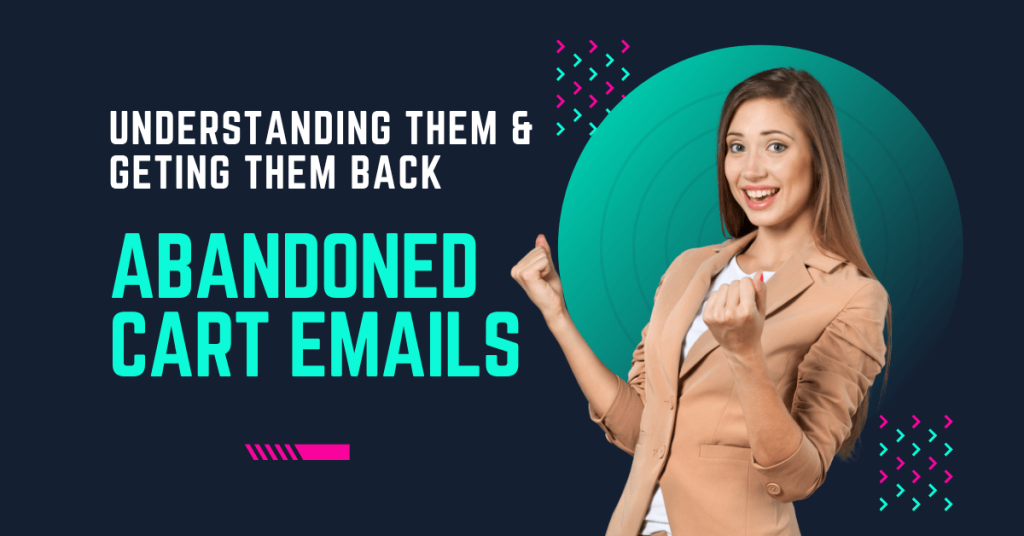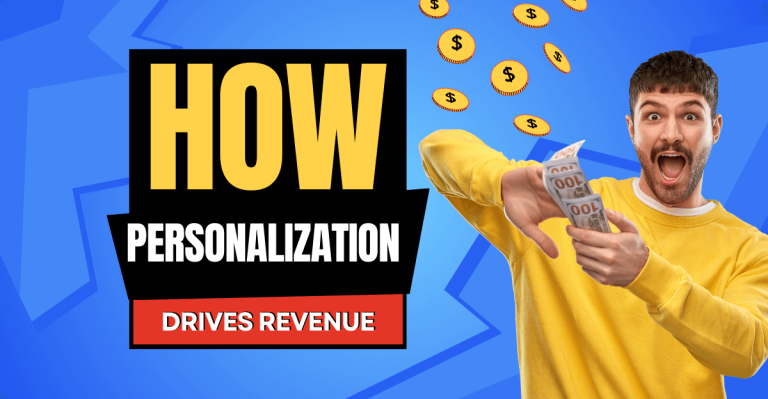Understanding Cart Abandonment Behavior
Abandoned cart emails are automated messages sent to online shoppers who place items in their cart but leave the site before completing the purchase. These emails act as strategic reminders, gently nudging users to return and finish the checkout process. When implemented correctly, they can significantly boost your ecommerce revenue by turning hesitation into conversion.
Whether through personalized product images, timely delivery, or exclusive offers, these emails help reconnect with potential customers when their buying intent is at its highest.
Cart abandonment happens when a customer adds items to their online shopping cart but leaves before completing the purchase. It’s common—over 70% of carts are abandoned across ecommerce stores.
This doesn’t always mean the shopper changed their mind; often, it means something interrupted their journey. It could be an unexpected fee, a lengthy form, or simply a moment of distraction. When brands understand what causes this behavior, they can respond with strategic recovery tactics—like email flows tailored to the shopper’s intent.
- Most shoppers abandon due to friction, not disinterest
- Use behavioral data to uncover abandonment patterns
- Recovery starts by addressing where and why users exit
Why Customers Leave Without Buying
Not every abandoned cart is a lost sale—many are delayed decisions.
Shoppers frequently pause purchases for reasons beyond price. Sometimes they want to compare options, revisit later, or just got pulled away from their device. Others might be surprised by added costs or frustrated by account creation. Identifying and resolving these barriers can make your cart recovery emails more effective.
- Hidden shipping fees and required account sign-ups create drop-offs
- Distractions and multi-device shopping lead to forgotten carts
- Addressing objections directly in follow-ups improves returns
Why Abandoned Cart Emails Work So Well
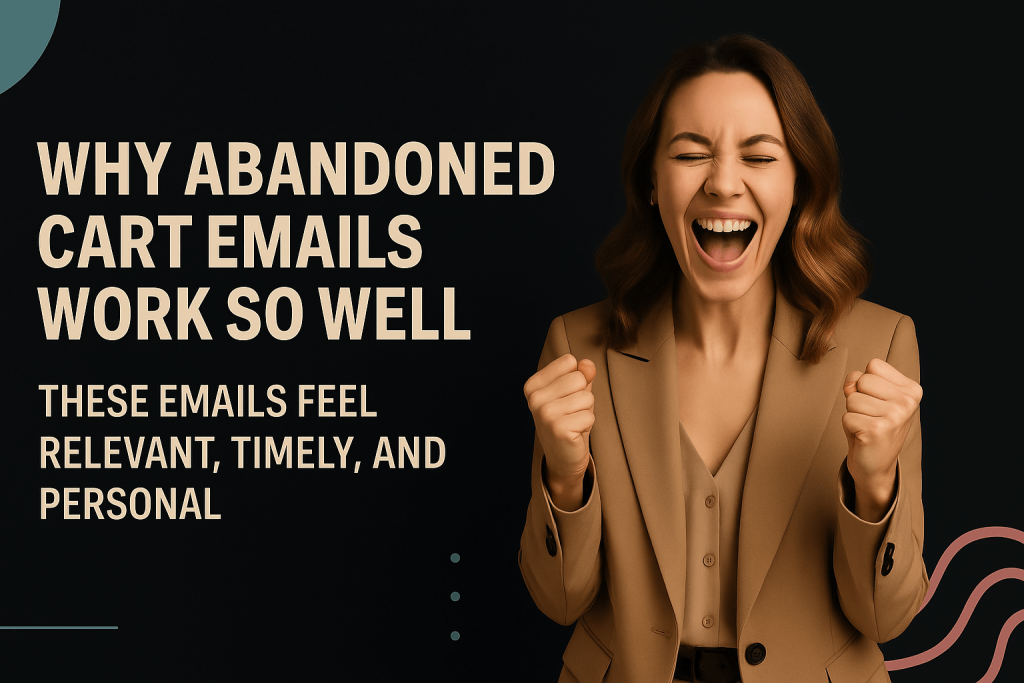
These emails succeed because they feel relevant, timely, and personal.
Abandoned cart emails aren’t random promotions—they’re responses to an action the customer already took. That’s why they feel less intrusive and more helpful. By reminding someone about an item they cared enough to add to their cart, you’re tapping into a moment of genuine intent.
- High-intent timing leads to stronger engagement
- Personalization makes these emails feel custom-made
- Customers appreciate a gentle reminder over aggressive marketing
Psychological Triggers at Play
Effective cart recovery emails use psychology to influence behavior, not manipulate it.
Shoppers who’ve placed an item in their cart have already made a small mental commitment. Cart emails build on that with triggers like urgency, FOMO (Fear of Missing Out), and loss aversion—pushing them toward completing the loop they started.
- Highlight scarcity: “Only a few left!”
- Use loss framing: “Don’t lose your cart”
- Offer incentives sparingly to trigger reciprocity
Trust, Timing, and Relevance
The more timely and relevant your email, the more trustworthy it feels.
Sending a recovery email within an hour of cart abandonment feels helpful. Including the product image and addressing the user by name reinforces that this message is specifically for them. That level of personalization builds trust and increases conversion.
- Send the first email within 30–60 minutes
- Match tone to brand voice—friendly, not pushy
- Include cart contents and support contact in every email
Stats That Prove the Power of Cart Recovery Emails
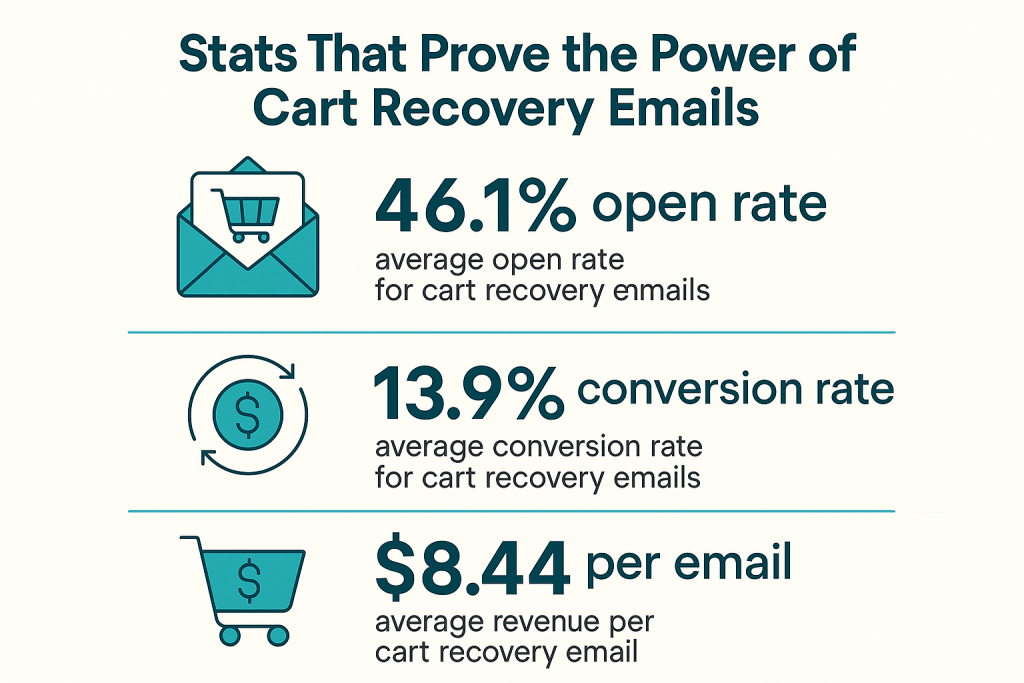
The performance metrics of cart emails consistently outshine regular marketing emails.
According to 2024 data from Klaviyo and Omnisend, cart recovery emails average:
- Open rates: 45–60%
- Click-through rates: 15–20%
- Conversion rates: 10–20%
- Revenue recovery: $5–$13 per email sent
This makes them one of the highest ROI tools in the ecommerce toolkit.
- Triggered emails outperform bulk campaigns in every category
- Consistent recovery rates add thousands to monthly revenue
- Even small list improvements can yield major financial returns
3-Email Cart Recovery Flow: The Perfect Sequence
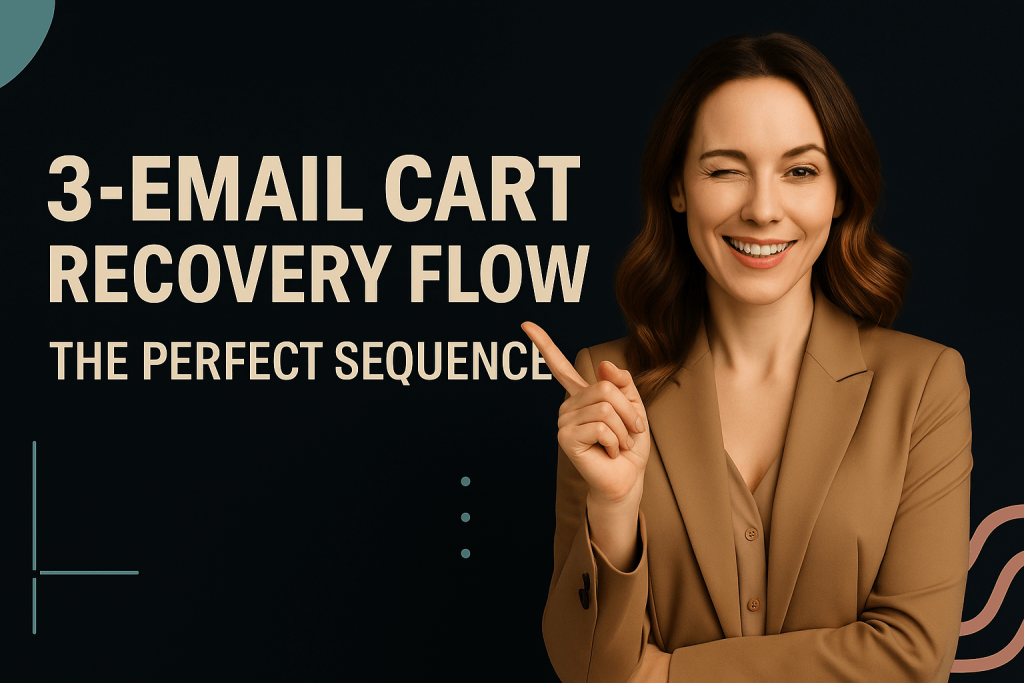
A single follow-up email is better than none—but a sequence is best.
Using a structured 3-part email sequence allows you to address different types of hesitation: forgetfulness, indecision, and procrastination. Each email builds on the last—moving from reminder to reassurance to urgency—without overwhelming your customer.
- Structure matters: start soft, add value, finish strong
- Timing: 1 hour, 12–24 hours, and 48 hours post-abandonment
- Each email should have a specific goal and CTA
Email 1: Friendly Reminder (1 Hour Later)
This email catches the shopper while their interest is still fresh.
Keep the tone light and helpful. Let them know their cart is waiting, and offer an easy way back. Include a clear CTA and link directly to their saved cart.
- Subject ideas: “Still thinking it over?” or “Oops—you left something behind”
- Show abandoned product with price and availability
- Include help/support options in case they had issues
Email 2: Social Proof or Offer (12–24 Hours Later)
Now’s the time to rebuild confidence or sweeten the deal.
If the shopper didn’t return after the first email, use the second to reinforce product value. Include customer reviews or user-generated content. You can also introduce a mild incentive like free shipping or 10% off.
- Share testimonials from other happy customers
- Add urgency with limited-time offers
- Reinforce benefits and guarantee terms
Email 3: Final Chance with Urgency (48 Hours Later)
This last email is about giving the shopper one final push.
Use urgency to spark action. Let them know time is running out or the item is at risk of going out of stock. Reiterate the value and keep the CTA bold and prominent.
- Focus on simplicity—one message, one action
- Subject lines: “Your cart expires soon” or “Last chance to claim your deal”
- Use countdowns or “only X left” indicators
Design & Copy Tips That Convert
Strong design and sharp copy are essential in turning opened emails into completed purchases.
Even if your timing is perfect, poor visuals or confusing messaging can sink the email’s performance. The design should clearly highlight the abandoned product and make the next step obvious. Every element—from imagery to language—should guide the user back to checkout. Simplicity and clarity win. Avoid overwhelming the customer with multiple links or irrelevant content.
- Use clean layouts that focus on one product or cart summary
- Prioritize mobile-friendly formatting and large CTA buttons
- Write with clarity, empathy, and purpose
Use Product Images & Dynamic Content
Visual cues help the shopper reconnect emotionally and practically with their cart.
Showing the exact product left behind reminds them of what they liked. Dynamic content takes this further—filling in product names, variants, and prices automatically for each customer. This creates a sense of continuity and personalization that static emails can’t replicate.
- Include large, clear product images with color/size variations
- Auto-fill content based on user’s cart activity
- Use dynamic product grids for multiple items
Craft Killer Subject Lines
Your subject line is your first (and sometimes only) chance to make an impression.
Cart recovery subject lines need to stand out while remaining relevant. The best ones either spark curiosity, create urgency, or personalize the message. Avoid gimmicky phrases or words that might trigger spam filters. Be authentic and strategic with your language.
- Keep it under 50 characters for mobile readability
- Use personalization tokens: “[Name], your cart’s ready”
- Highlight urgency or curiosity without sounding pushy
Include a Clear CTA
The clearer your call to action, the more likely customers are to follow through.
Every abandoned cart email should have one prominent CTA button, leading directly back to the checkout page. Avoid multiple links that create decision fatigue. Reinforce the CTA with complementary text that reminds users of what’s waiting and why it’s worth finishing.
- Use action phrases: “Complete My Order” or “Get It Now”
- Place the CTA above the fold and repeat it at the bottom
- Ensure the button leads to a pre-filled cart with a seamless checkout flow
Segmentation & Personalization in Abandoned Cart Flows
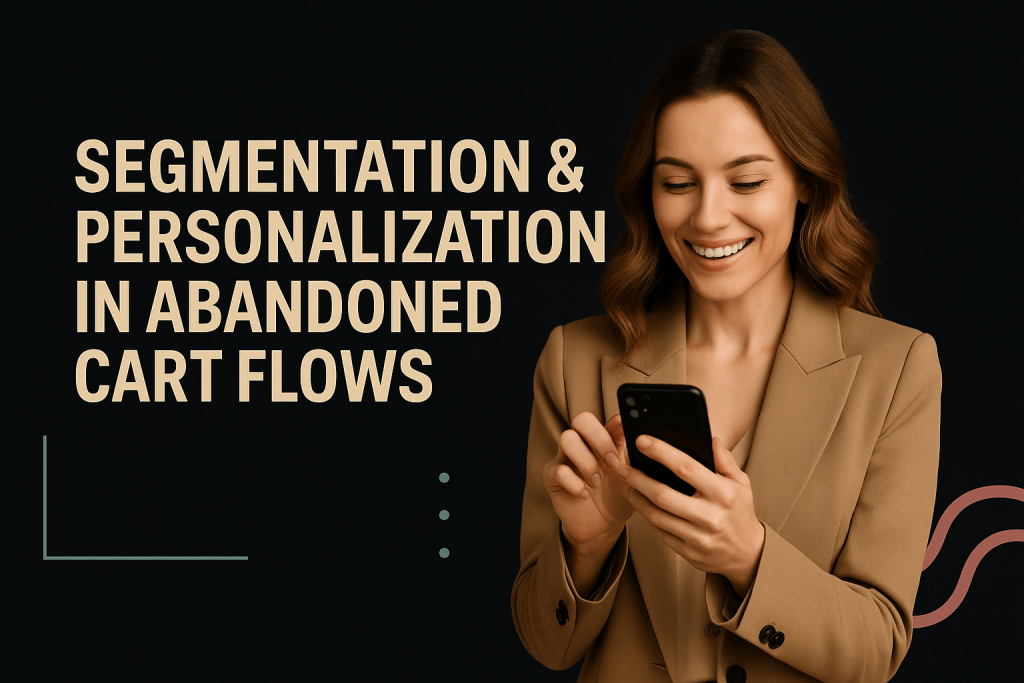
Tailoring your message based on customer behavior significantly increases conversions.
Not every customer abandons for the same reason, so your recovery efforts shouldn’t treat them all the same. Segment your audience based on cart size, purchase history, or device used. Then personalize the content accordingly—offering loyalty perks to VIPs or testimonials to first-time buyers. Intelligent segmentation ensures the message matches the moment.
- Customize emails by customer type: new vs. returning
- Vary incentives based on average order value
- Personalize messaging by browsing or cart history
Segment by Cart Value or Buyer Behavior
Larger carts may need assurance, while smaller carts might respond better to urgency.
High-value shoppers might be taking their time because of the investment. Offer guarantees, reviews, or exclusive benefits. Meanwhile, small-cart users are often driven by convenience or fear of missing out. Adjust your tone, CTA, and incentives accordingly.
- High-cart value: reinforce trust with return policies and product benefits
- Low-cart value: emphasize speed, urgency, and simplicity
- Use custom flows for repeat vs. first-time buyers
Dynamic Recommendations Based on Abandoned Items
Don’t stop at reminding them of what they left—suggest what they might also love.
By recommending complementary or related products, you’re not only increasing order value but also enhancing user experience. For example, if someone abandoned a tent, show them a sleeping bag or lantern in the follow-up. Use browsing history or product tags to build smart recommendations.
- Suggest accessories or frequently bought-together items
- Highlight top-rated products from the same category
- Feature limited-time bundles to incentivize larger orders
A/B Testing Your Cart Abandonment Emails
Even a small tweak can yield major results—testing helps you find what works best.
Cart abandonment flows aren’t set-it-and-forget-it. Regular A/B testing helps you optimize subject lines, timing, layout, discounts, and CTA placement. Run one test at a time so you can accurately attribute performance changes. Over time, these tests will compound into significant gains in conversion and revenue.
- Test different subject lines: emotional vs. factual
- Try varying delays between emails
- Compare performance with and without a discount
Legal & Deliverability Best Practices
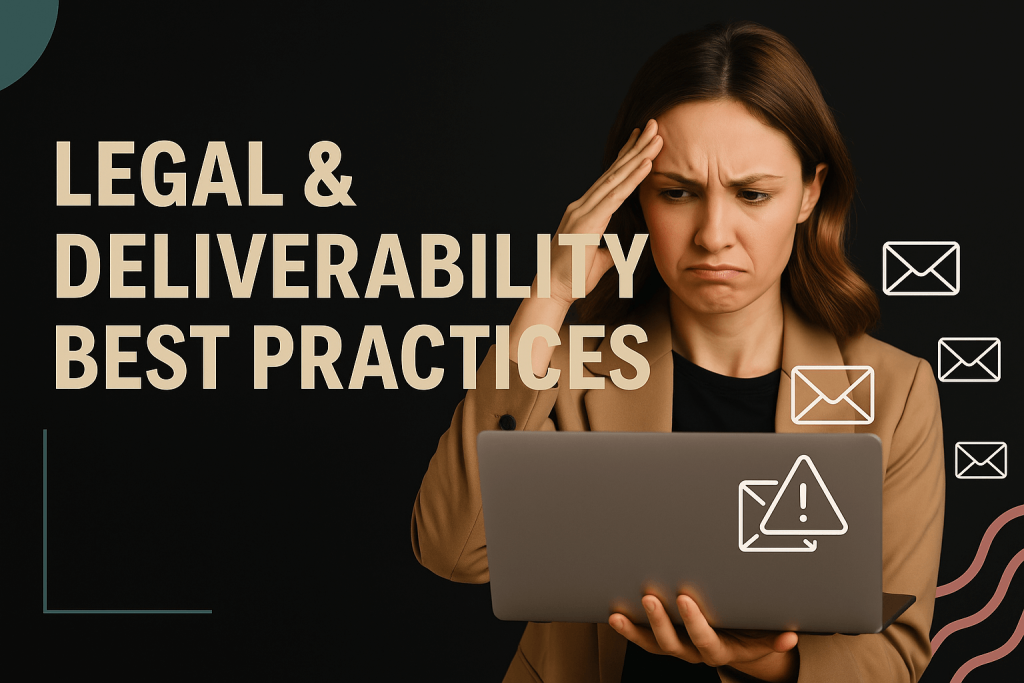
Compliance ensures your emails are ethical, legal, and reach the inbox.
Abandoned cart emails can only be sent to users who’ve opted into marketing communications. In addition, including an unsubscribe link, using a clean sender reputation, and avoiding spam trigger words help protect your deliverability. Following global privacy laws like GDPR and CCPA isn’t just mandatory—it builds trust.
- Only email users who consented to receive marketing messages
- Always include a visible unsubscribe link
- Use verified sending domains and avoid misleading subject lines
Real Brand Case Study: 25% Revenue Recovery with Klaviyo
A real-world example shows how powerful abandoned cart emails can be when done right.
A mid-sized jewelry ecommerce brand partnered with The Mail Effect to implement a structured 3-email recovery flow using Klaviyo. Within the first 30 days, the brand saw a 27% cart recovery rate. Their open rates increased to 54%, and click-through rates rose from 8% to 19% after A/B testing subject lines. Small changes in tone and design led to big returns.
- $18,400 in revenue recovered in one month
- CTR improvement after optimized subject lines
- Proof that behavior-based automation outperforms generic email blasts
FAQs: Abandoned Cart Emails for Ecommerce
How many abandoned cart emails should I send?
Three emails strike the perfect balance: reminder, reassurance, and urgency.
Should I include discounts in every cart email?
No. Start without an offer. Use incentives only in the second or third email.
When is the best time to send cart recovery emails?
The first email should go out within an hour, with follow-ups at 12–24 and 48 hours.
Can these emails be automated and personalized?
Yes. Tools like Klaviyo and Omnisend allow dynamic personalization based on customer behavior.
What’s the best platform for setting up abandoned cart flows?
Klaviyo, Omnisend, Mailchimp, and ActiveCampaign all offer robust automation features.
Are these emails GDPR and CCPA compliant?
They are, as long as you’ve obtained user consent and include clear opt-out links.
Don’t Let Sales Slip Away—Automate Cart Recovery Today
Abandoned cart emails are one of the most effective and accessible ways to recover lost revenue. By sending the right message at the right time, you can convert hesitation into action—and build long-term trust with your customers.
If you’re not using cart recovery flows yet, you’re leaving money on the table. And if you’re using them but not optimizing them, you’re still missing out.
At TheMailEffect, we help ecommerce brands design branded, high-converting email sequences that bring customers back and boost revenue—automatically.

